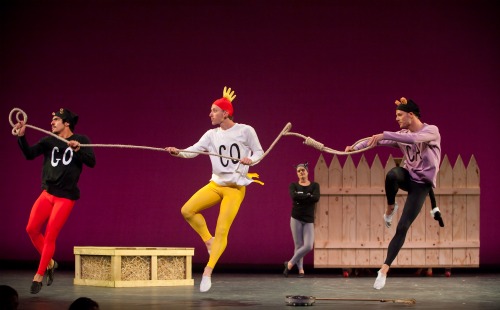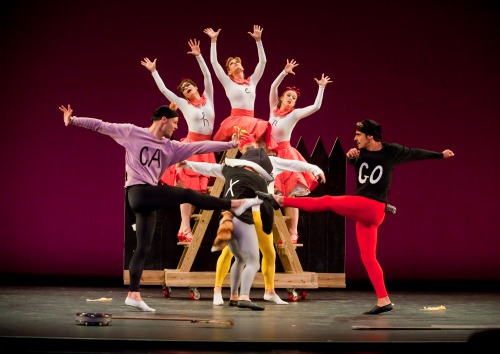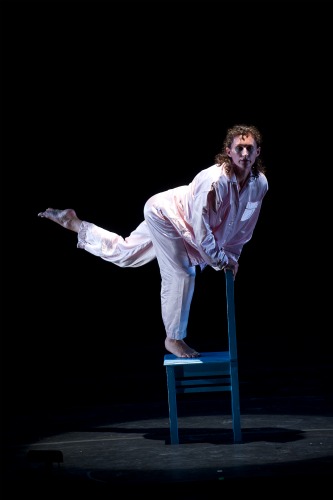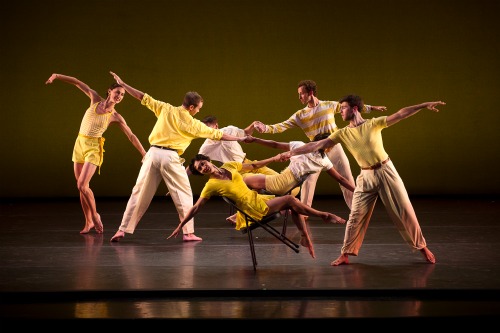When it comes to selecting music to spark choreography, Mark Morris is an omnivore. He gives loving, uncondescending attention to popular songs like George Gershwin’s “Someone to Watch Over Me,” Jerome Kern’s “Two Little Bluebirds, or (once) Yoko Ono’s “Dogtown,” as well as digging into scores by Bach, Stravinsky, Schumann and other musical giants.
To Lincoln Center’s Mostly Mozart Festival, from August 18 through 20, the Mark Morris Dance Group brought new and recent dances set to compositions by Stravinsky (Renard), Johann Nepomuk Hummel (Festival Dances), and Eric Satie (Socrate). Last week, at Jacob’s Pillow, MMDG performed to music by Richard Rodgers (Resurrection, 2002), Alexander Tcherepnin (Ten Suggestions, 1981), Schumann (V, 2001), and arrangements by Ethan Iverson of pop songs recorded long ago by Gertrude Lawrence and Jack Buchanan (Dancing Honeymoon, 1998).
Since the company maintains a larger repertory than other mid-sized dance troupes, it can tailor programs to fit a particular venue or occasion. Although there were no dances by Morris to Mozart’s music at the Mostly Mozart Festival this year, Hummel was a protégé of Mozart’s; Stravinsky profoundly admired Mozart; and Satie. . .well, he, like Stravinsky was one of the bright young fellows writing music in early twentieth-century Paris. This year MMDG celebrated its 30th anniversary. Since it first appeared at Jacob’s Pillow in 1986, and its 2011 appearance there featured a work from each of three decades. Both those programs were enhanced by live music performed by the Mark Morris Music Ensemble, conducted at the Rose Theater by Stefan Asbury.
Morris approaches music in various related ways; often, as in V, the ambiance, as well as the structure, inspires him. If there are words, the choreography may allude to them. During the song “And Her Mother Came Too” in Dancing Honeymoon, Amber Star Merkens sweetly, but firmly finds ways to interpose herself between the newlyweds.
If there’s a pre-existing scenario, Morris finds ways both to honor it and to put his own mischievous stamp on it, often accenting both music and plot in ways the composer might not have thought of. In the bushy-tailed little Resurrection, Morris abstracts the plot of the “Slaughter on Tenth Avenue Ballet” from the 1936 Rodgers and Hart musical On Your Toes. Maile Okamura is killer, victim, and numbly drifting ghost to Noah Vinson’s wandering hero. The ensemble, smartly clad in Isaac Mizrahi’s black-and-whites, is given to gesturing with two-finger guns. The dance hall girl’s kicks become a Busby Berkeley effect by a circle of dancers lying on the floor. Everyone dies, everyone lives.
You can bet that Morris’s version of Stravinsky’s Renard (which had its premiere at Tanglewood earlier in the summer) owes little to Bronislava Nijinska’s Renard of 1922, Serge Lifar’s of 1929, or George Balanchine’s of 1947. Stravinsky, who wrote the music in 1915, termed his work (drawn from Alexander Afanasyev’s collection of Russian folk tales) a “burlesque” and envisioned acrobats, as well as dancers and four singers (two tenors, a baritone, and a bass in the MMDG’s performance).
It’s a nutty tale, with overtones of Tyl Eulenspiegel, the unkillable mischief-maker who mocks the clergy and the aristocrats. The singers exchange roles or double them. The fox, masquerading as a nun, tries to kill the foolish cock, who is saved more than once by his friends, the cat and the goat. In the end, the fox is both stabbed and hanged, but survives—at least in spirit.
In line with Morris’s impudent and rambunctious take on the tale, Maira Kalman has dressed the animals for an athletic meet. The men (Fox, a female in the scenario, is played by a man, Dallas McMurray) wear tights and jerseys— with their names, in lieu of numbers, split between their chests and backs. For instance, Goat (Domingo Estrada Jr.) shows “GO” in front and “AT” when he turns. They all have appropriate tails.
Morris has added three hens (alluded to in the text by the fox, who—deceptively virtuous in his nun’s headgear—chides the cock for having a harem). Rita Donohue, Laurel Lynch, and Jenn Weddel are decked out as 1950s cheerleaders with bouffant red skirts and red headdresses, their skimpy pom-poms doubling as blood spatter. A nice touch: Lynch sports Sarah-Palin glasses. The outside fence of the henhouse has three concealed holes, through which the ladies poke their heads from to time. When the fence is swiveled by the performers, we see the ladder that functions as Cock’s perch.
Like characters in a Martha Graham epic, each of these, except for the roving Fox, has a home base. Cat (William Smith III) preens and stretches on a crate of hay; Goat, tethered, grazes at the opposite side of the stage. That is, when they’re not playing prop instruments that mimic the tambourine and cimbalom in the score, or stalking Fox with outsized knife and noose. The performers are deliciously clever at conveying animal behavior (for instance, the chickens’ nervously craning necks and pecking heads) and character (McMurray’s sly and bawdy stroking of the cock’s feathered tail). This isn’t a piece you relish for the dancing, but Aaron Loux’s solo expressing the endangered Cock’s penultimate flutter is a wonderfully loose, boneless affair.
Every time I revisit a dance by Morris, I notice things I’d missed—for example, the different ways he uses walks and runs in the beguiling Festival Dance and in Socrate. In the former, steps ripple like Hummel’s Piano Trio in E Major, Op. 83 and betoken an eagerness on the part of the celebrants to get into new, sociable patterns. In Socrate, the dancers’ treading echoes the heavy-footed motif of a dirge that you hear deep within Satie’s music, and their deployment in space can evoke a frieze, like those that travel around the pediment of a Greek temple. In the last part of this grave and beautiful work, the ongoing walking, like a tide, casts up images from Socrates’s last hours, with different dancers becoming the philosopher, while others serve as his bed, his comrades, the cupbearer.
The more familiar I become with a work of Morris’s, the more I’m struck by how he uses repetition and variation. In the dialogue between Socrates and Phaedrus (a translation of the French text appears in supertitles), dancers rest supine by the river Illissus, with one arm thrown across their brows. When a similar movement occurs in “The Death of Socrates” section, it suggests suffering and presages the philosopher’s end and his disciples’ grief.
In the first movement of the gorgeous V, set to Schumann’s Quintet for Piano and String, Op. 44, Morris plays striking games with those V-shapes the dancers form, angling the point now toward the audience, now away from us. Particularly enthralling is the moment when the squad of bare-legged performers in Martin Pakledinaz’s flowing blue shirts and briefs shares the stage with the squad in form-fitting, pale green tops and matching trousers. Each group dances in a V, one facing downstage, one upstage But they overlap slightly at the center, so that when the two come together and the dancers open and round in their arms the way they did at the very beginning of V, the middle dancers embrace not air, but members of the opposite team. It’s a touching hint of the much later passage in the dance, when people throw themselves against their partner’s chests and fold their arms fervently around these momentary lovers.
Morris gets his ideas from music, but what he hears can spark unusual gambits. In Alexander Tcherepnin’s early piano piece “Bagatelles, opus 5” —perhaps because of the composer’s work with a nine-step scale—tonality is beset with small, prickly dissonances that tend not to resolve. Accordingly, in Ten Suggestions, the solo for himself that Morris set to this music, ideas are embarked upon and abandoned. Performed with marvelous wit, skill, and timing by Merkens, the ten little numbers could be seen as skewed versions of old-time vaudeville acts that the performer is trying out (or maybe dreaming up; the costume is pajamas, and the first sounds that the excellent musician Colin Fowler draws from the piano act upon Merkens like a wakeup call).
Each of these “suggestions” is elegantly put, however dubious the performer is about them. Reacting to each new musical texture, Merkens practices somersaults and rolls; does a tiptoe-walk through some kind of pattern on the floor, hiking up her pantlegs; thinks about a hoop dance, a chair dance. She tries to devise something with a ribbon, dons a solar topee for a number that doesn’t materialize, makes some grand gestures. She also spins on one leg in an ecstasy of discovery, her body arching, her head thrown back, but she ends by covering her face like a kid who’s just spilled her milk.
Who knows what impelled Morris to make three folding chairs a major choreographic ingredient in Dancing Honeymoon? There’s no end to what seven dancers can do with them. At one point, some performers sit, while others hold their hands and pass between them—flying into the air, making the chairs rock and causing those seated to kick their legs in time to the tender, arch, or jaunty old tunes (nicely sung by Danya Katok). Morris is also adroit with musical jokes in this, like having the dancers in “Goodnight, Vienna” repeatedly fall to the floor and smack a hand emphatically against it to give a back-beat oomph to the silence at the end of a phrase.
As he has often said, he’s lucky to have such musical dancers. Those in Dancing Honeymoon are Samuel Black, John Heginbothem, Loux, Merkens, Okamura, Vinson, and Michelle Yard. This is as good a time as any to say what a strong presence Black has become; suddenly he’s a standout. I haven’t mentioned all the dancers, but their distinctive charms are firmly fixed in my memory.





Morris premiered Dancing Honeymoon in his home town, Seattle, and I adored it, particularly “And her mother came, too.” I think he’s a master at humor without being cute about it, which isn’t easy. And thank you Deborah for providing another take on Renard, adding to the description so that I can see how it differs from Balanchine’s.
Tickets were sold out for their Mostly Mozart performance. Would be great to see them do a longer run next year. Obviously its a big hit.